 |
"Oregon's
Rogue River
Valley
& the Railroad, 1911"
|
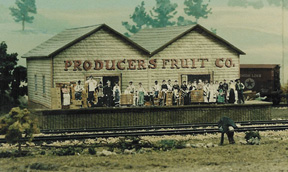
A photographer takes a picture of the workers at the Producers Fruit Co.
This scene is taken from the actual historic photo taken by a real photographer.
|
|
| |
|
1998
-- Jacksonville
Children's Museum, So. OR Historical Assn, Medford, OR
Size: 22 in. deep
x 22 in. tall x 75 ft. long
Scale: 1/8 in. = 1 ft. (1/87th scale, or HO gauge)
Figures: over 166 at 3/4 in. tall + 78 animals (horses, cattle, dogs,
cats, etc.)
Features: interactive working railroad, historically accurate; 54
buildings; 720 trees; system for interactive
questions / answers (lights illuminate portions of the diorama to illustrate
answers to questions) |
|
|
| |
|
|
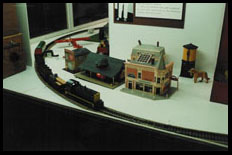 |
|
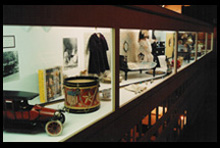 |
|
LEFT:
The second floor display case of the Jacksonville, Oregon Children's Museum
as it was before the conversion of the case to house the Moments In Time
exhibit, "Oregon's Rogue River Valley and the Railroad, 1911".
The Children's Museum building was originally built
in 1910 as the county jail. |
|
|
| |
|
|
|
The Problem: The Jacksonville Children’s
Museum had to replace a long-standing exhibit featuring antique toys and
an interactive HO scale railroad. It ran through a display case perched
upon the second floor balcony railing of what used to be the County Jail.
Their desire was to install a diorama relating to what people in the area
did for a living around the turn of the century (1900), but at the insistence
of their visitor base, they wanted to keep an interactive train. The balcony
railing was 25 feet on its long sides, and 13 feet on its short sides,
joined at the corners and without any partitions. The inside space provided
a continuous display area two feet deep, two feet high and 75 feet long.
|
|
|
|
The Challenge: Through research, determine
what did the people living in the Rogue River Valley do for a living in
the early 1900’s, then design and create a diorama that depicts people
engaged in those activities, tying each of these scenes together with
the passage of a still-interactive railroad through the work vignettes.
In addition, the client was interested in including other interactive
elements relating to these work activities.
|
|
|

Panning for gold. |
|
|
| |
|
|
|
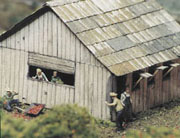
Women in the apple packing shed tease a young worker for spilling his wheelbarrow
load of apples.
|
|

Apple pickers swarm the orchards at picking time.
|
|
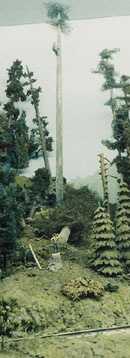
Timber toppers at work. |
|
|
|
|
|
|
|
|
|
|
|
|
|
|
|
|
|
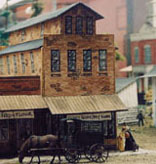
Jacksonville was the county seat until the railroad bypassed the community.
|
|
|
|
|
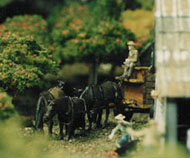
Teams and wagons thread their way through the trees heavy with fruit.
|
|
|
|
|
|
The Solution: Our
research with the Southern Oregon Historical Society archives identified
seven primary work activities - orchards, farming, mining, lumber, sports
recreation (the Rogue River was a popular fishing venue even then), education
(the college in Ashland) and the growing presence of the developing mainline
railroad through the valley with a large switching yard also in Ashland.
Seven different work scenes were designed to fit around the display, plus
the town center of Jacksonville. Four other area towns were also represented
with their train depots, including Ashland’s train yard and its robust
station. Because the display case was only 22” deep, about 165 feet
in real life size - it was useful to employ the modeling technique of
selective compression to help accommodate the scenes. The archives were
able to provide some excellent historical photos which were converted
to photo murals, then painted and used as backdrops for some of the scenes,
also providing a greater sense of depth. The scenes were separated by
raised platforms whose bases were landscaped to blend into the scenes,
and upon which related artifacts and historical photos were displayed.
Each scene included a bit of action related to a question panel below
the display window. A button, when pushed, activated a narrow beam spotlight
to illuminate the action which answered the question. When the railroad
button was pressed, the train - also researched and historically accurate
for the period - left the depot in Talent, OR and proceeded to wind through
the scenes, stopping for ten seconds at the stations in Medford, Woodville
(later to become Rogue River), and Ashland before returning to Talent
to await the next press of the button. "All aboard!?"
|
|
|
|
|
|
|
|
|
|
|
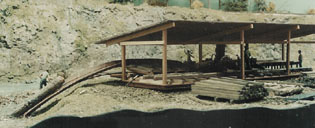
Many early sawmills in the region were quickly set up along waterways to
convert timber to railroad ties.
|
|
|
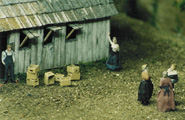
During harvest season, many women worked in the fruit packing sheds. |
|
|
|
|
|
|
|
|
|
|
|
|
|
|
|
|

Looking west into downtown Medford through the use of a photo-mural as a
backdrop as the train makes one of its four stops. The photo mural is made
from an historic photo, enlarged to meet the model's scale, hand-painted
to blend in, and trimmed to fit.
|
|
|
|
|
|
|
|
|
|
|
|

In addition to panning for gold and shaft-mining, placer or hydraulic mining
was used effectively in areas in south west Oregon in the early 1900's,
employing many men and artificially eroding many hillsides and valley edges.
|
|
|
|
|
|
|
|
|
|
|
|
|
|
|
|
|
|
Website designed by Moments In Time Exhibits
Contact webmaster
with comments/questions.
|
|
|
|
|
|
|
|
|
|
|
|
|
|
|
|
|
|
|
|
|
|
|
|
|
|
|
|
|

